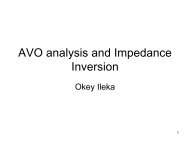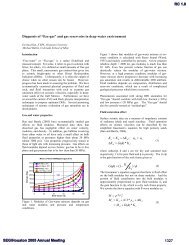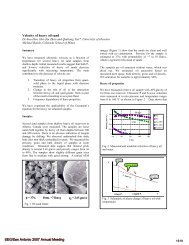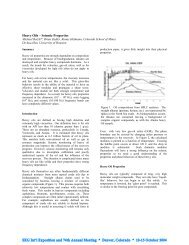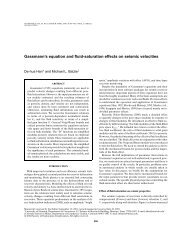Phase scanning method for detuning in thin bed - Rock Physics ...
Phase scanning method for detuning in thin bed - Rock Physics ...
Phase scanning method for detuning in thin bed - Rock Physics ...
Create successful ePaper yourself
Turn your PDF publications into a flip-book with our unique Google optimized e-Paper software.
<strong>Phase</strong> <strong>scann<strong>in</strong>g</strong> <strong>method</strong> <strong>for</strong> <strong>detun<strong>in</strong>g</strong> <strong>in</strong> th<strong>in</strong> <strong>bed</strong><br />
Fang Li * , Siyuan Cao * , Dehua Han # , Jian Yao +<br />
* State Key Laboratory of Petroleum Resource and Prospect<strong>in</strong>g(Ch<strong>in</strong>a University of Petroleum,Beij<strong>in</strong>g);<br />
#<br />
University of Houston; + Tianj<strong>in</strong> Branch Company of CNOOC(Ch<strong>in</strong>a) Ltd., Tianj<strong>in</strong><br />
Summary<br />
Th<strong>in</strong> <strong>bed</strong> response is one of key concerns <strong>in</strong> seismic<br />
amplitude <strong>in</strong>terpretation, ow<strong>in</strong>g to tun<strong>in</strong>g effect that<br />
depends on both thickness and offset. We propose a<br />
<strong>method</strong>ology to remove tun<strong>in</strong>g effect <strong>in</strong> order to obta<strong>in</strong> true<br />
amplitude. Traditional <strong>detun<strong>in</strong>g</strong> <strong>method</strong>s can’t handle nonzero<br />
phase wavelet and can’t effectively remove tun<strong>in</strong>g<br />
effects of th<strong>in</strong> layer with thickness above λ /8 when the<br />
tun<strong>in</strong>g effect is most severe. In this study we proposed a<br />
new <strong>method</strong>, called phase <strong>scann<strong>in</strong>g</strong>, that has potential to<br />
solve this problem. The synthetic study shows that our<br />
<strong>method</strong> is effective to any k<strong>in</strong>d of wavelets, noise tolerant,<br />
and applicable to a wide range of thickness of the th<strong>in</strong>-<strong>bed</strong>.<br />
Introduction<br />
Seismic amplitude is a crucial parameter <strong>in</strong> seismic data<br />
<strong>in</strong>terpretation. True amplitude can render more reliable and<br />
valuable <strong>in</strong>terpretation results <strong>for</strong> risk reduction associate<br />
with seismic exploration, especially <strong>for</strong> th<strong>in</strong>-<strong>bed</strong> reservoirs.<br />
Tun<strong>in</strong>g effect from the <strong>in</strong>terference of two seismic waves<br />
from closely spaced <strong>in</strong>terfaces affects seismic amplitude<br />
related to rock and fluid properties. Correct<strong>in</strong>g tun<strong>in</strong>g<br />
amplitude is currently a difficult problem.<br />
Different approaches <strong>for</strong> correct<strong>in</strong>g tun<strong>in</strong>g amplitudes to<br />
un-tun<strong>in</strong>g amplitudes have been proposed. Widess (1973)<br />
first discussed the tun<strong>in</strong>g effect of th<strong>in</strong> <strong>bed</strong>s systemically<br />
and concluded that at a layer thickness of a quarter of the<br />
dom<strong>in</strong>ant wavelength of the zero-phase wavelet, maximum<br />
amplitude <strong>in</strong>terference occurs. L<strong>in</strong> and Phair(1993)<br />
proposed a correct<strong>in</strong>g factor as a function of both thickness<br />
and offset <strong>for</strong> quantitative calculation on th<strong>in</strong> <strong>bed</strong>s bounded<br />
by layers that have the same rock properties of top and base<br />
layer when us<strong>in</strong>g a zero-phase wavelet. Chungt and<br />
Lawton(1995) developed analytical expressions <strong>for</strong> a zerophase<br />
Ricker wavelet and thickness below λ /8,where λ is<br />
the dom<strong>in</strong>ant wavelength <strong>in</strong> the layer . Bakke and<br />
Urs<strong>in</strong>(1998) presented a tun<strong>in</strong>g correction factor <strong>for</strong> a<br />
general seismic wavelet and <strong>for</strong> offset data. Tun<strong>in</strong>g<br />
amplitude factors <strong>for</strong> common offset of AVO and AVA<br />
cases were developed by Urs<strong>in</strong> and Tygel (2007).<br />
<strong>Phase</strong> <strong>scann<strong>in</strong>g</strong> <strong>method</strong><br />
The <strong>method</strong>s mentioned above are <strong>in</strong>applicable <strong>for</strong> nonzero<br />
phase wavelets and large thickness of the order of λ /8.<br />
And these situations commonly occur <strong>in</strong> real seismic data.<br />
For th<strong>in</strong> <strong>bed</strong>s, thickness less than one-eighth of the<br />
dom<strong>in</strong>ant wavelength, the character of the reflection is that<br />
of the time derivative of the <strong>in</strong>cident wavelet (Widess<br />
1973). Based on the differentiation property of the Fourier<br />
trans<strong>for</strong>m, a time-derivative equates to phase rotation of -<br />
90 degree <strong>in</strong> the frequency doma<strong>in</strong>. As a dynamic<br />
parameter of seismic waves, phase changes the wave<strong>for</strong>m<br />
<strong>in</strong> time doma<strong>in</strong>. From this po<strong>in</strong>t of view, the response of<br />
th<strong>in</strong> <strong>bed</strong>s with<strong>in</strong> a certa<strong>in</strong> range of thicknesses can be<br />
considered as a complex wave where the phase is unlike<br />
that of orig<strong>in</strong>al wavelet.<br />
The phase <strong>scann<strong>in</strong>g</strong> <strong>method</strong> we proposed removes the<br />
tun<strong>in</strong>g effect of th<strong>in</strong> <strong>bed</strong>s, and applies to larger thicknesses<br />
compared to time-derivative <strong>in</strong>dividually. Transmission<br />
loss, <strong>in</strong>ternal multiples and other mechanisms of energy<br />
loss are ignored and dispersion is not <strong>in</strong>cluded.<br />
Theory<br />
The response of th<strong>in</strong> <strong>bed</strong>s may be approximated by the two<br />
primary P- wave reflections (Bakke and Urs<strong>in</strong> 1998),<br />
giv<strong>in</strong>g<br />
( , ) ( )( ( ) ( ))<br />
S t y = R y P t −P t−Δ T (1)<br />
where t and y denotes time and offset respectively. R( y )<br />
is the reflection coefficient and<br />
traveltime.<br />
ΔT<br />
The correspond<strong>in</strong>g frequency expression is then:<br />
is the two-way<br />
( )<br />
−i2π<br />
fΔT<br />
S ( f, y) = R ( y) P( f ) − e P( f )<br />
i ( f )<br />
Simplify<strong>in</strong>g and us<strong>in</strong>g P( f ) e θ to denote P ( f )<br />
results <strong>in</strong>:<br />
( , ) 2 ( ) ( ) s<strong>in</strong>( π )<br />
i( + )<br />
S f y = R y P f fΔ T e θ α (2)<br />
SEG Houston 2009 International Exposition and Annual Meet<strong>in</strong>g<br />
346<br />
Downloaded 13 Nov 2009 to 129.7.247.181. Redistribution subject to SEG license or copyright; see Terms of Use at http://segdl.org/
where, P ( f ) and ( f )<br />
θ are the amplitude spectrum<br />
and phase spectrum of p()<br />
t respectively. The quantity<br />
0<br />
α = π f ΔT<br />
− 90 is additional phase as an <strong>in</strong>dicator of th<strong>in</strong><br />
<strong>bed</strong>s. Hence, th<strong>in</strong> <strong>bed</strong>s add an additional phase α to<br />
orig<strong>in</strong>al phase of wavelet, and extra changes to the true<br />
amplitude of th<strong>in</strong> <strong>bed</strong>.<br />
The seismic response of th<strong>in</strong> <strong>bed</strong>s discussed here is<br />
composed of two waves with opposite polarity. The<br />
response of upper layer of a th<strong>in</strong> <strong>bed</strong> can be expressed as:<br />
( ) ( )<br />
i ( f )<br />
= (3)<br />
S f, y R y P( f ) e θ<br />
top<br />
The purpose of our work is to extract the top response <strong>in</strong><br />
equation (3) from the overall response of the th<strong>in</strong> <strong>bed</strong><br />
through equation (2). If the seismic response of the base<br />
layer is expected, the same <strong>method</strong> can be adopted <strong>for</strong><br />
<strong>detun<strong>in</strong>g</strong> estimation.<br />
The flows <strong>for</strong> the <strong>method</strong> applied to a synthetic data set are<br />
concluded as follows:<br />
• Generate synthetic data us<strong>in</strong>g the reflectivity <strong>method</strong><br />
<strong>in</strong> a simple model based on th<strong>in</strong> <strong>bed</strong> em<strong>bed</strong>ded <strong>in</strong> two<br />
half-spaces, as shown figure 1;<br />
• Apply phase rotation to the data to atta<strong>in</strong> <strong>scann<strong>in</strong>g</strong><br />
data with<strong>in</strong> a limited range of the phase <strong>in</strong>crements;<br />
In general, the behavior of phase rotation can be<br />
descri<strong>bed</strong> as phase adapter without any change to<br />
amplitude spectrum. It can be easily obta<strong>in</strong>ed by<br />
Hilbert trans<strong>for</strong>mation <strong>in</strong> time doma<strong>in</strong>.<br />
• For each trace of new data, per<strong>for</strong>m correlation<br />
analysis with the response from the top layer to<br />
f<strong>in</strong>d<strong>in</strong>g the most fitt<strong>in</strong>g phase- <strong>in</strong>crement (α ). The<br />
result can be written as:<br />
( ) ( )<br />
i<br />
2 R y P( f) s<strong>in</strong> π fΔ T e θ (4)<br />
• Apply an amplitude correction to obta<strong>in</strong> the<br />
approximate response from the top of th<strong>in</strong> <strong>bed</strong>, which<br />
is comparable to the exact response <strong>in</strong> equation (3).<br />
From equation (4), there are two terms to be corrected,<br />
one of them is a constant 2; the other is the s<strong>in</strong>e term<br />
which <strong>in</strong>clude thickness and frequency. The latter can<br />
be estimated by α . In addition, offset-dependent<br />
tun<strong>in</strong>g factor, say cosθ (θ is transmitted angle of th<strong>in</strong><br />
layer), should be considered (see L<strong>in</strong> 1993);<br />
Figure.1 Th<strong>in</strong> <strong>bed</strong> model<br />
(<strong>in</strong>cident angle between 0 o and 40 o .)<br />
Lithology Density Vp Vs (kft/s)<br />
(g/cm 3 ) (kft/s)<br />
Shale(top) 2.16 7.19 2.684<br />
Sand 2.11 7.0 2.82<br />
Shale(bottom) 2.16 7.19 2.684<br />
Table 1 <strong>Rock</strong> and fluid parameters used as an example<br />
Examples<br />
Layer elastic model with two horizontal reflection<br />
<strong>in</strong>terfaces (figure 1) is assumed to <strong>for</strong>m a synthetic record,<br />
which is to be convoluted with a 30Hz Ricker wavelet of<br />
zero-phase or 90 o -phase and maximum amplitude of 1. The<br />
parameters of each layer are showed <strong>in</strong> table 1. Reflection<br />
coefficients of the top and base layer are of opposite<br />
polarity but have similar magnitudes. Note that the<br />
thickness discussed here is the tun<strong>in</strong>g thickness ( λ /4).<br />
Synthetic datum of the two cases are shown <strong>in</strong> figure 2<br />
(zero-phase case) and figure 3 (90 o -phase case). Left<br />
response (red) of each figure is modeled data with<br />
reflectivity <strong>method</strong> as tun<strong>in</strong>g data, the plot <strong>in</strong> magenta is<br />
the <strong>detun<strong>in</strong>g</strong> data estimated by our <strong>method</strong>. The referenced<br />
<strong>detun<strong>in</strong>g</strong> amplitude (blue) is assumed to be the response of<br />
the separated top layer <strong>in</strong> our calculation. The curves <strong>in</strong><br />
right of the figures are m<strong>in</strong>imum amplitude (because of the<br />
negative magnitude of top reflection coefficient.) of three<br />
relevant data sets as color drew <strong>in</strong> synthetic datum. As<br />
expected, tun<strong>in</strong>g amplitude is removed greatly, which is<br />
very near to the <strong>detun<strong>in</strong>g</strong> response except <strong>for</strong> far offset <strong>in</strong><br />
figure 2 and 3. The results show that there are no<br />
requirements needed govern<strong>in</strong>g the wavelet so that it is<br />
attractive to real seismic data <strong>in</strong>terpretation.<br />
To be more realistic, uncorrelated noise has to be added to<br />
synthetic data. Tests <strong>for</strong> a given noise levels was conducted.<br />
Figure 4 shows a test <strong>for</strong> noise with S/N ratio of 2. It<br />
<strong>in</strong>dicates the <strong>method</strong> can also provide encourag<strong>in</strong>g results<br />
<strong>in</strong> such cases. Because noise added have effect on<br />
SEG Houston 2009 International Exposition and Annual Meet<strong>in</strong>g<br />
347<br />
Downloaded 13 Nov 2009 to 129.7.247.181. Redistribution subject to SEG license or copyright; see Terms of Use at http://segdl.org/
amplitude of each record time. So the <strong>method</strong>s based on<br />
process<strong>in</strong>g of amplitude will be <strong>in</strong>fluenced more or less by<br />
noise <strong>in</strong>evitably. However, wave<strong>for</strong>ms seem not to be<br />
<strong>in</strong>sensitive to noise.<br />
Conclusion<br />
The tun<strong>in</strong>g effect, as one of the most serious factors<br />
hamper<strong>in</strong>g confident lithology and fluid <strong>in</strong>terpretation from<br />
seismic data, must be considered, especially <strong>for</strong> th<strong>in</strong>-<strong>bed</strong><br />
<strong>in</strong>terpretation.<br />
seismic data. However, additional research is required <strong>for</strong> a<br />
more general case of unequal rock properties above and<br />
below the th<strong>in</strong>-<strong>bed</strong>, i.e. low-contrast layer or high-contrast<br />
layer.<br />
Acknowledgements<br />
This study was supported by Fluids/DHI consortium that is<br />
sponsored by the oil <strong>in</strong>dustries all over the world. Also we<br />
would like to thank Jeremy K<strong>in</strong>g, Fuyong Yan andQiuliang<br />
Yao <strong>for</strong> their helpful comments.<br />
Here, we study this problem <strong>in</strong> terms of the phase and<br />
present a new <strong>method</strong> called phase <strong>scann<strong>in</strong>g</strong> <strong>method</strong>. Our<br />
<strong>method</strong> exhibits stability to seismic data with acceptable<br />
noise and expands the range of th<strong>in</strong> <strong>bed</strong> thickness studied <strong>in</strong><br />
other papers to above the λ /8. Also there is no assumption<br />
of the wavelet we used, so it is more applicable to real<br />
Figure.2 Seismic responses <strong>for</strong> the case of tun<strong>in</strong>g thickness ( λ /4) and zero-phase Ricker wavelet. Left: tun<strong>in</strong>g response; Middle:<br />
Un-tun<strong>in</strong>g response (blue) and calculated data (magenta); Right: m<strong>in</strong>imum amplitude of each trace from correspond<strong>in</strong>g seismic<br />
responses (see colors). The most Fitt<strong>in</strong>g data is obta<strong>in</strong>ed when correlation coefficient equal to 0.98, and addition phase here is<br />
-110 o .<br />
SEG Houston 2009 International Exposition and Annual Meet<strong>in</strong>g<br />
348<br />
Downloaded 13 Nov 2009 to 129.7.247.181. Redistribution subject to SEG license or copyright; see Terms of Use at http://segdl.org/
Figure. 3 Seismic responses <strong>for</strong> the case of tun<strong>in</strong>g thickness ( λ /4) and 90 0 phase Ricker wavelet. Left: tun<strong>in</strong>g response; Middle:<br />
Un-tun<strong>in</strong>g response (blue) and calculated data (magenta); Right: extreme of amplitude of each trace from correspond<strong>in</strong>g seismic<br />
responses (see colors). The most Fitt<strong>in</strong>g data is obta<strong>in</strong>ed when correlation coefficient equal to 0.97, and addition phase<br />
here is -115 o .<br />
Figure. 4 Seismic responses with random noise of S/N=2 <strong>for</strong> tun<strong>in</strong>g thickness and zero phase Ricker wavelet. Left: tun<strong>in</strong>g<br />
response; Middle: Un-tun<strong>in</strong>g response (blue) and calculated data (magenta); Right: extreme of amplitude of each trace from<br />
correspond<strong>in</strong>g seismic responses (see colors). The most Fitt<strong>in</strong>g data is obta<strong>in</strong>ed when correlation coefficient equal to 0.78, and<br />
addition phase here is -125 o .<br />
SEG Houston 2009 International Exposition and Annual Meet<strong>in</strong>g<br />
349<br />
Downloaded 13 Nov 2009 to 129.7.247.181. Redistribution subject to SEG license or copyright; see Terms of Use at http://segdl.org/
EDITED REFERENCES<br />
Note: This reference list is a copy-edited version of the reference list submitted by the author. Reference lists <strong>for</strong> the 2009<br />
SEG Technical Program Expanded Abstracts have been copy edited so that references provided with the onl<strong>in</strong>e metadata <strong>for</strong><br />
each paper will achieve a high degree of l<strong>in</strong>k<strong>in</strong>g to cited sources that appear on the Web.<br />
REFERENCES<br />
Bakke, N.E., and B. Urs<strong>in</strong>, 1998, Th<strong>in</strong>-<strong>bed</strong> AVO effects: Geophysical Prospect<strong>in</strong>g, 46, 571–587.<br />
Chung H., and D. C. Lawton, 1995, Frequency characteristics of seismic reflections from th<strong>in</strong> <strong>bed</strong>s: Canadian Journal of<br />
Exploration Geophysics, 31, 32–37.<br />
H. Chung, and D. C. Lawton, 1999, A quantitative study of the effects of tun<strong>in</strong>g on AVO effects <strong>for</strong> th<strong>in</strong> <strong>bed</strong>s: Canadian Journal<br />
of Exploration Geophysics, 35, 36–42.<br />
Hilterman, F.J., 2001, Seismic amplitude <strong>in</strong>terpretation: SEG.<br />
L<strong>in</strong>, L., and R. Phair, 1993, AVO tun<strong>in</strong>g: 63rd Annual International Meet<strong>in</strong>g, SEG, Expanded Abstracts, SEG, 727–730.<br />
Rojas, M. and D. Han, 2005, Tun<strong>in</strong>g effect on fluid properties estimated from AVO <strong>in</strong>version: 74th Annual International<br />
Meet<strong>in</strong>g, SEG, Expanded Abstracts, 1465–1468.<br />
Tetyukh<strong>in</strong>a et al., 2007, High resolution th<strong>in</strong> <strong>bed</strong> <strong>in</strong>version based on the Bayesian approach, 69th Annual Conference and<br />
Exhibition, EAGE, Extended Abstracts, 357–361.<br />
Widess, M. B., 1973, How th<strong>in</strong> is a th<strong>in</strong> <strong>bed</strong>: Geophysics, 38, 1176–1180.<br />
SEG Houston 2009 International Exposition and Annual Meet<strong>in</strong>g<br />
350<br />
Downloaded 13 Nov 2009 to 129.7.247.181. Redistribution subject to SEG license or copyright; see Terms of Use at http://segdl.org/



